A food critic walks into a burger bar in the year 2039. “Welcome to McFuture’s, madam. Plant or Cultured?” the iGraze screen asks. Payment is by retina scan, and the food is served by a lifelike server bot on a hot white plate with a gingham napkin.
Anything our future food critic doesn’t wolf down is tipped into an anaerobic digester that helps power the building. Alongside it there’s a shipping container painted like a birch forest. Inside, all the salad vegetables are growing without soil or sun. Beside the container sits something that looks like a microbrewery, a group of stainless steel containers on stilts. In each one, the equivalent of the meat and fat of two cows is being grown each month, to be ground into burgers, slapped in a freshly toasted bun and dressed with a pickle.
Livestock suck up 70% of the planet's fresh water, constitute the world's biggest polluter of water, and are a huge contributor to biodiversity loss. Eating meat has become a political act

Far-fetched as it all sounds, the most unrealistic element in our 2039 burger might be the continued existence of the food critic. Every other ingredient could be on your food horizon in the next decade, if not sooner.
In 1956, The Irish Times looked through its future vision goggles at the century up ahead with a study from the California Institute of Technology. "Our eating habits are going to change," it declared. "We shall eat less meat and instead, will rely on plants, even the stalks and leaves." Sea algae will be a food source, the 1950s report said. But only for a domesticated "sea-pig which would live on algae and make food for humans".
Right about the potential of algae. Wrong about the sea pigs. But those 1950s futurologists were fundamentally wrong about a future world that would eat less meat. In 1956 there were 2.8 billion people in the world, less than half of today’s 7.6 billion global population. Almost 70 years later, the massive environmental hoofprint of livestock farming would be jaw-dropping to those 1950s scientists.
Today, farming animals for protein uses almost 50 per cent of the world’s farmland for grazing and growing feed crops. Livestock suck up 70 per cent of the planet’s fresh water, constitute the world’s biggest polluter of water, and are a huge contributor to biodiversity loss. Eating meat has become a political act.
Until recently, the tech industry had little interest in food. Silicon Valley gave us Soylent, a sort of Complan for coders, dinner they could slurp through a straw because tech kids were as interested in cooking as they were in stamp collecting. But biotech has turned its gaze on our dinner, and is reinventing food, especially meat.
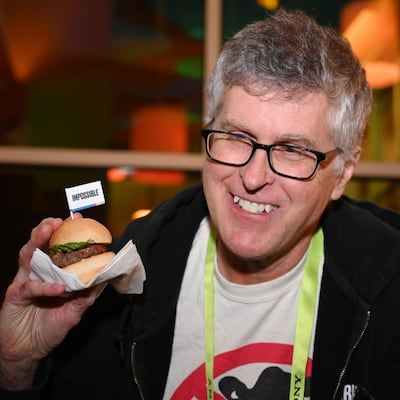
The lead scientist is a spectacled man with spiked pepper and salt grey hair. Stanford biochemistry professor Pat Brown gave an interview in front of an audience in Stockholm in June. His T-shirt (worn under a grey business suit, naturally) featured a cow’s head in a red circle with a line through it.
Brown, the founder of Impossible Foods, told the audience at Eat Stockholm: “We’re using the wrong technology to produce these foods. We’re using a prehistoric technology that’s incredibly inefficient and destructive, and hasn’t fundamentally improved in millennia.”
A decade ago Brown decided that today’s most pressing scientific question was not how to cure disease, but to figure out what made meat delicious. After years of research and taste testing (an early prototype burger tasted like rancid polenta) the Impossible Whopper went mainstream this year. The burger, first made from wheat and now made from soy, went on the menu of more than 7,000 Burger Kings in the United States. The breakthrough was a discovery of a protein molecule extracted from fermented yeast called heme, similar to hemoglobin, which gives the Impossible Whopper the bloody taste of meat.
A plant-based chicken burger and beef burger has been rolled out in Sweden, Brazil and parts of Asia, and earlier this month Burger King in Ireland launched its Rebel Whopper, a meat-like soya-and-wheat burger made by the Dutch-based Vegetarian Butcher company.
Many experts believe plant protein will be a stepping stone to cultured meat, flesh grown from biopsied cells in vats, taking slaughter-free meats from lab experiments to supermarket shelves in the next decade.
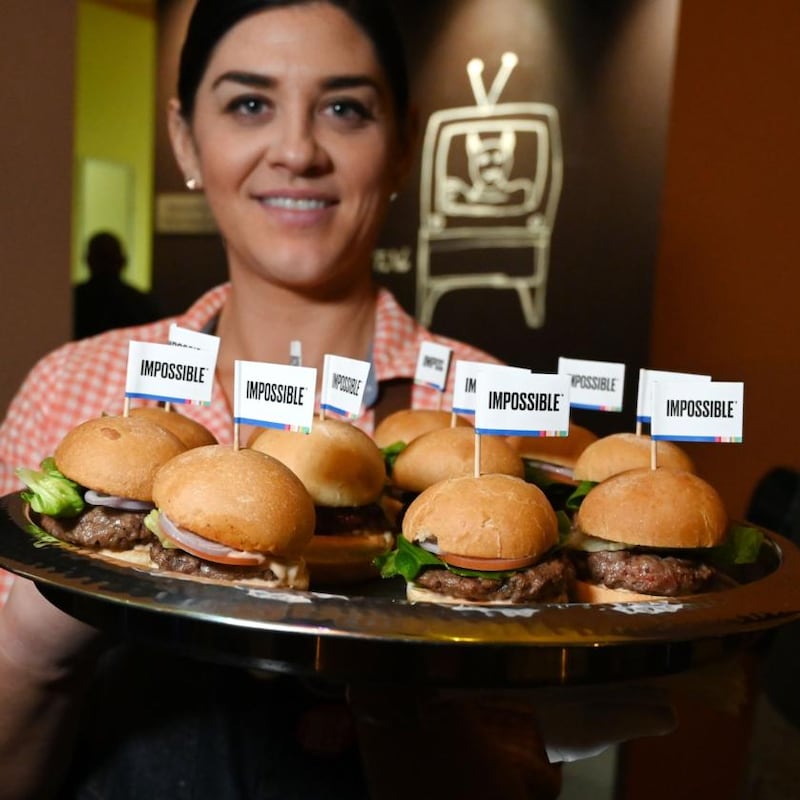
In her brilliant new book, The Fate of Food, the American journalist Amanda Little visits Memphis Meats in Berkeley, California, a stone's throw from the home of the slow-food activist Alice Waters's Chez Panisse. Memphis Meats founder Uma Valeti was inspired by an unlikely futurologist in the shape of Winston Churchill. In a 1931 article, Fifty Years Hence, Churchill predicted a hyperconnected world and one in which we would, "escape the absurdity of growing a whole chicken in order to eat the breast or wing by growing these parts separately under a suitable medium."
The first milestone in lab-grown meat was reached six years ago, with a press conference to showcase a lab-grown burger. Since then the race has been to make it cheap and scalable enough to compete with, or even beat the costs of, commodity meat. Memphis Meats is one of several Californian, Dutch and Israeli companies in the race to grow meat in bioreactors.
It's clear to me that if I ate lab-grown duck gussied up with sauce and trimmings, as Peking duck or duck à l'orange, I wouldn't able to distinguish the meat from conventional duck
In her book, Little tastes a €550 portion of duck breast grown by Memphis Meats from a cluster of cells biopsied from a live duck (which she presumes is still quacking somewhere nearby). It tastes stringy, chewy and meaty. “It’s clear to me that if I ate the stuff gussied up with sauce and trimmings, as Peking duck or duck à l’orange, I wouldn’t able to distinguish the meat from conventional duck,” she says. Its ordinariness was what made it extraordinary.
Management consultants AT Kearney recently described “novel vegan meat replacements” like the Impossible Whopper as the “Generation 0”, saying cultured meat would be “Generation 1”, making the Impossible Whopper the Blackberry to the cultured meats’ iPhone.
"These start-ups already exert an attraction and glamour on young top graduates in their countries, similar to that expected from Google, Tesla or Apple," the Kearney report noted.
If it all sounds excitable, that’s because there’s money in taking even a small bite of the €1.5 trillion annual global meat market. And it’s a win for the planet too, taking the pressure off farms devoted to an inefficient system of farming protein, restoring and reforesting depleted soil, and freeing up land for more sustainable farming which gives farmers a better living.
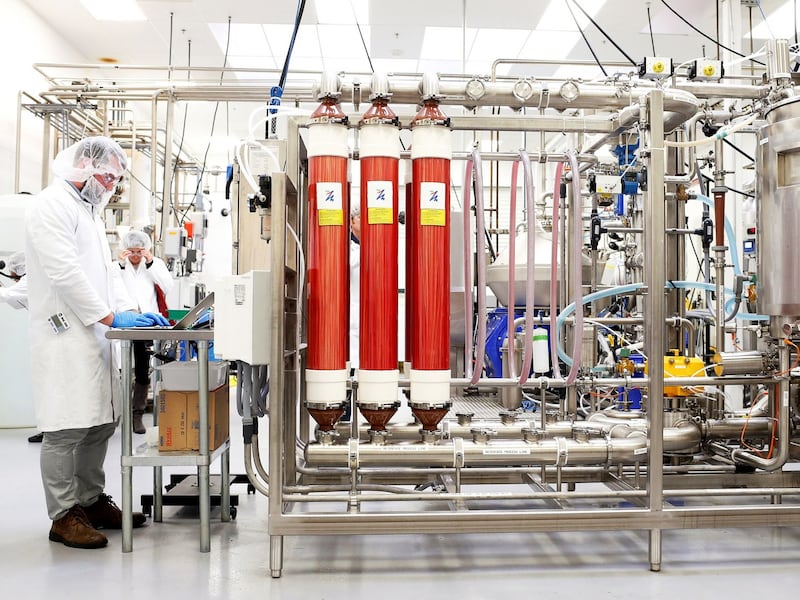
In October Israeli firm Future Meat Technologies announced a model that could bring the cost of cell-made steak down to about €20 a kilo, or about €9 if combined with plant-based meat. The company predicts that its technological leap will put lab-grown meat on supermarket shelves in three years. The company claims each refrigerator-sized bioreactor could grow a half ton of meat and fat in about 14 days, or two cows’ worth of meat in a month.
American science journalist Charles Mann’s book The Wizard and the Prophet argues that there are two siloed schools of thinking about facing future challenges. His “wizard” is Norman Borlaug, father of the “green revolution” that vastly increased crop production in developing countries, and winner of the Nobel Peace Prize in 1970. Borlaug’s combination of dwarf wheat with nitrogen fertiliser is credited with saving a billion lives in famine-prone countries. The wizards tell us to innovate to solve future problems.
Mann’s “prophet” figure is environmentalist William Vogt, who died in 1968 after a lifetime warning about overpopulation and overconsumption. Vogt urged people to cut back and return to a past where practices were more sustainable. As Little notes in her book, when it comes to food, we need a third way which sees wizards and prophets collaborate to haul us out of an ever-growing hole.
She follows this idea of a third path in a deep dive into the future of fish farming, water conservation and vegetable growing, and asks whether rediscovering forgotten or wild crops can feed a growing world without destroying ecosystems and pumping out ever more greenhouse gases.
We can assemble the anatomy of a possible future burger that might result from Little’s artisan biotech food future, where sustainable food can be made available to the biggest number of people for the longest amount of time. It’s a scenario where food becomes the fix rather than the problem.
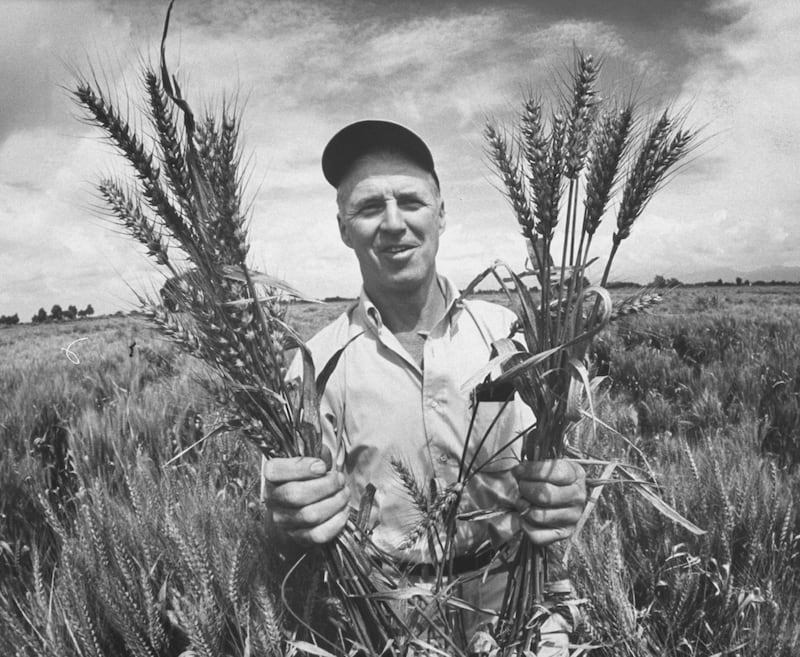
So our future food critic might face more options when she walks into a burger bar.
“Kernza or quinoa bun?”
“Wild rocket or aeroponic lettuce?”
“Purple fries with that?”
Kernza is a heritage grain that keeps growing wheat for up to five years without needing to be ploughed and replanted annually. Kernza’s roots grow 3 metres down, sequestering carbon, helping soil fertility and water retention. The catch (and there is always a catch) is that the grain is a fifth of the size of modern wheat grains.
Aeroponics could bring healthy vegetables to the city neighbourhoods where most of us will live in the future without the chilling or shipping costs
The other more recognisably foodie ingredient might be wild rocket. The peppery leaves, which seed themselves freely, have more flavour than milder cultivated versions and are therefore more nutritious. The more bitter the better for many leafy greens, as wild crops are being newly valued not only for their Noma-style status, but for their nutrition comparedwith depleted staple crops. Similarly, purple potatoes contain more nutrients than their white counterparts.
Aeroponics could see salad crops being grown from a fleece-like medium suspended in the air, with their roots sprayed with nutrients, giving them both the flavour and nutrition profile that’s been leeching out of depleted over-fertilised soils. Aeroponics could also insulate crops from increased carbon levels in the air, which are causing plants to grow faster but with lower nutrient values.
As Little points out, these systems have the potential to bring healthy vegetables to city neighbourhoods (where most of us will live in the future) without the chilling or shipping costs. A future food landscape might feature aeroponic farms in city zones, community gardens in the suburbs and food forests in rural areas, while some industrial farms continue to produce the vast stores of staple grains.
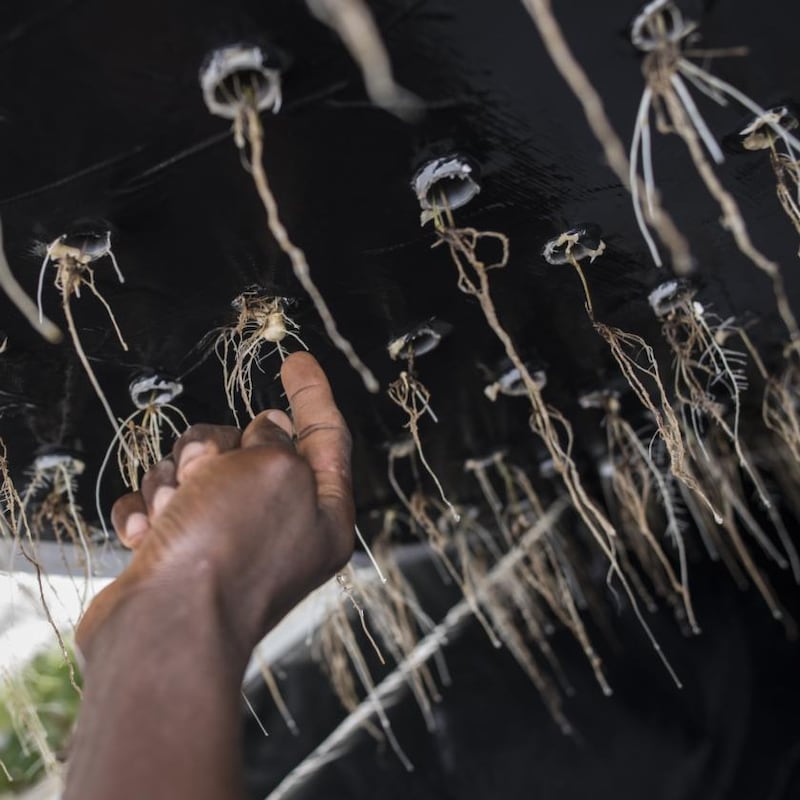
Is it dystopia or utopia, a sort of good life with apps, or a hellscape of processed frankenfoods where only the richest will eat well? As a country whose biggest industry is food, Ireland has more skin in the game than most.
Trinity botany professor Jane Stout is chair of the Irish Forum on Natural Capital which, she says was, “born from the point of view that we need to protect our natural environment, recognise it as something valuable”.
Was it an effort to turn business people into tree huggers? Stout smiles. “We do need to produce food, but we need to find a way of doing it that’s compatible with air, water, wellbeing, culture, spirituality” – all the things that come from the land.
A future where most meat is lab-based or comes from plant protein could be good. “But it depends on how the substitutes are grown,” she says. If that’s done the old way as a crop in a field, then that can be as damaging as livestock farming.
We need to look at the land with another lens. Fields are not just food factories, but resources for sequestering carbon, attenuating flood water, filtering pollutants, enhancing our physical and mental wellbeing
“We need to look at the land with another lens. Fields are not just food factories, but resources for sequestering carbon, attenuating flood water, filtering pollutants, enhancing our physical and mental wellbeing. We’re still thinking of what’s coming off the land on the basis of what we can trade in the markets. But it has value for other reasons.”
If commodity beef and dairy are going to be grown in labs, then “we need a plan for what happens to the land in a country where more than 80 per cent of farmland is based on feeding that market.”
What about the argument that we do beef and dairy in a much more environmentally friendly way than feedlot farms in the US, and Ireland’s food future is high-end, high-welfare farming? “Just being better than someone else isn’t enough,” Stout says. “What does Ireland want to look like in 10 years time? We’re a small island on the edge of a continental land mass. We need to look at what we have, see how far we’ve pushed it, and realise we don’t want to push it any further.
“We have 11,000 species of insects in Ireland, and most of them we don’t know anything about, their ecology or where they are,” Stout adds. We also don’t know how they will react to changing climate. “The more diverse an ecosystem, the more resilient it is to change. We need to apply that to our food system. We need diversity.”
Thomas and Claire O’Connor bought a 10-hectare (25-acre) sheep-farm in Gleann na nGealt, in Camp, Co Kerry, 12 years ago. As the paperwork was being processed, the grazed bare fields grew a crop of docks, a sign of compacted soil. “So we took over a farm of docks,” Thomas says. His parents weren’t farmers, but every year he spent three months on his grandfather’s farm, where much of the work was done by hand.
Now their farm is a model of farming diversity. Last month they won the Farming for Nature award, set up last year by the Burrenbeo Trust, a landscape charity based in Galway. They grow vegetables, salads, wheatgrass, poultry and eggs. Every two years they farm pigs, mainly for their own consumption. Thomas does most of the farming, and Claire runs the shop in Tralee, Manna Organic Store, where they sell much of their produce.
They have a small farm payment and a forestry grant for their trees, with 6ha (15ac) of native Irish woodland, but the income from the shop and farm gives them both a living and allows them to employ two people and seasonal part-time farm workers.
Their first steps in farming went against the grain. “We immediately converted to organic and started planting hedgerows, alder and elder, dividing up our fields,” Claire explains. They expanded tree planting around the edges of fields. Making fields smaller has all kinds of benefits for the environment, but the single farm payment system rewards the opposite approach. “You’re taking from your acreage [for which you’re paid], and it’s harder to get machinery in.”
We wanted to manage our land in a different way that was a more cost-effective way of producing beef and lamb. We were also discovering that meat raised on pasture is healthier for humans to eat
Their farmer neighbours have been “really supportive”. One neighbour converted her sheep farm to an organic farm. Claire says she is in “an extremely unique position” with her work in the shop. “I’ve met most people whose foods we are eating.”
They are brilliant advocates for a healthy farming system. For years they knew that talking about biology or the environment was not what farmers did. “It was all about money, profits and export,” Thomas says. “But there’s a new story around. Farming needs to be about food and community.”
Consumers have a better understanding of livestock farming, and how not all meat is the same, according to Russ Carrington of the British Pasture for Life organisation. Consumers are driving a demand for meat reared entirely on pasture, he says. The Pasture for Life label is now available to Irish farmers, and around a half a dozen beef and sheep farmers, along with some dairy farmers, are seeking to become accredited members in Ireland in recent months.
Carrington spoke in Portlaoise last week at a BioFarm conference organised by the National Organic Training Skillnet. Pasture for Life is a label used by more than 500 farmers in Britain, he explains in an interview before his talk. It was set up in 2011 by a dozen farmers interested in finding a market for meat raised on pasture, rather than the conventional model of grass-fed animals finished on grain.
“We wanted to manage our land in a different way that was a more cost-effective way of producing beef and lamb. We were also discovering that meat raised in this way [on pasture] is healthier for humans to eat.” Pasture-fed meat has a higher omega-3 and vitamin content.
Pasture for Life farmers in the UK sell in couriered meat deliveries, and through short supply chains like supplying a local butcher. Some London restaurants were beginning to take an interest in the label, and if the supply chains got longer, Pasture for Life could become a supermarket presence, Carrington says.
What does Carrington make of cultured meats? “Let’s see what kind of energy is involved in creating these products,” he says. “Cattle and sheep can create these products at very low cost.”
Clive Bright, one of the 10 finalists in the Burrenbeo Trust-supported Farming for Nature awards, farms beef and lamb on his farm in Sligo on a grass-only diet. He moves his cows between dozens of paddocks on the farm in the growing season, mob grazing fresh long grasses so he doesn't need to feed them grain to get them to weight. The animals are slaughtered in a small abattoir, and Bright sells beef and lamb directly online on his website Rare Ruminare.
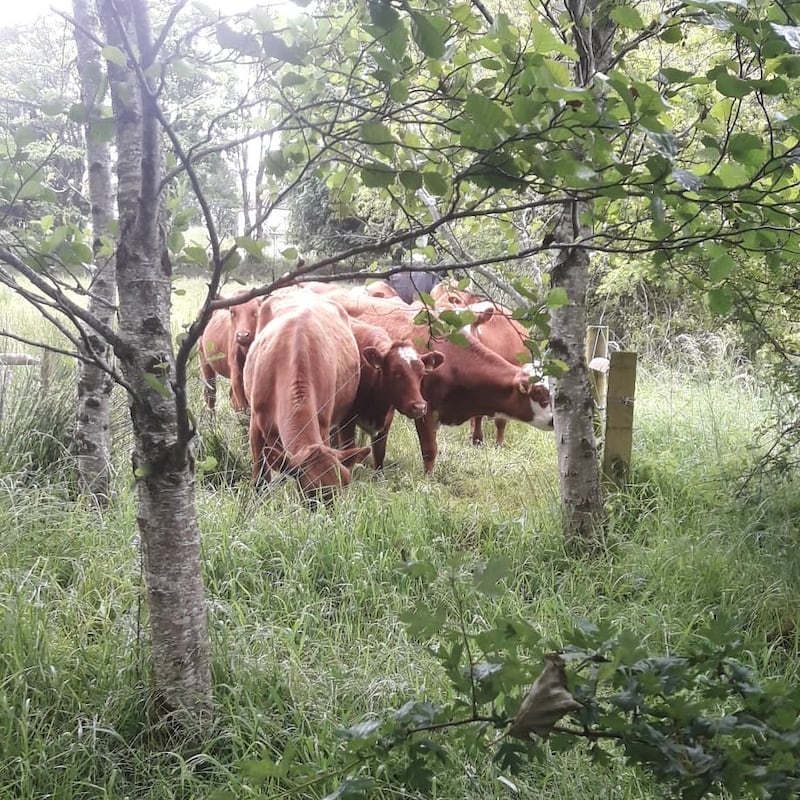
“I had an ingrained love for doing things in a natural way, but it was also for profit,” he explains. High fertiliser and feed costs were only going to take from his income, and his ultimate goal is to over-winter the animals in the fields and eliminate his wintering costs, to be “farming for free” on the farm that he inherited from his mother. Rare Ruminare beef sells for €14 a kilo and his customers love it.
“I’ve had people who had stopped eating meat, a couple of well-informed vegetarians who were doing it from the point of view of the production model that didn’t fit with their ethics. They came back to eating my meat.” His aim is to reduce the size of his animals to make them more efficient. He’s just introduced a Moiled bull to the herd, “and the quality of the flavour will go up another level”.
It has taken less than a generation for pasture-fed organic meat and dairy to become a niche product. It could take just a decade for that model to return to being the norm
Bright believes his model of beef farming is the “solution” to the image of meat as a destroyer of the planet. Regenerative grazing management means soil can sequester the emissions from his animals, and a silvopasture system of planned tree planting will enhance the soil and also cycle the carbon. “The way I’m really looking at it is creating a habitat, where livestock are a part of that biodiversity.”
A food future where cultured meat and dairy might be indistinguishable and cheaper than its livestock-based counterpart brings Irish agriculture to a crossroads. It has taken less than a generation for pasture-fed organic meat and dairy to become a niche product. It could take just a decade for that model to return to being the norm.
Animals grazing in small permanent pasture fields with a diverse diet of herbs and grasses, vibrant hedgerows, with silvopasture areas where trees are used to feed, drain and maintain healthy soil are all needed to make meat a palatable part of the diet of someone who cares. The model presents a win-win scenario for the environment, greenhouse gas emissions and the health of rural Ireland.
The market for cheap meat looks set to be disrupted and transformed. A new farming movement is growing from the ground up. Given the choice between a lab steak and a zero carbon pasture-fed Irish Moiled sirloin, I know where my future money would be spent.
The Fate of Food: What We'll Eat in a Bigger, Hotter, Smarter World, by Amanda Little, is published by Oneworld




















